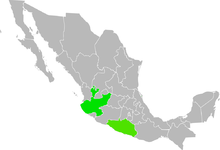Pluteus nevadensis
| Pluteus nevadensis | |
|---|---|
| Scientific classification | |
| Kingdom: | Fungi |
| Division: | Basidiomycota |
| Class: | Agaricomycetes |
| Order: | Agaricales |
| Family: | Pluteaceae |
| Genus: | Pluteus |
| Species: | P. nevadensis |
| Binomial name | |
|
Pluteus nevadensis Rodr.-Alcánt. (2010) |
|
 |
|
| Known only from the Mexican states Guerrero and Jalisco |
|
| Pluteus nevadensis | |
|---|---|
| Mycological characteristics | |
| gills on hymenium | |
|
|
cap is conical or campanulate |
| hymenium is free | |
| stipe is bare | |
| spore print is pinkish-brown | |
| ecology is saprotrophic | |
Pluteus nevadensis is a species of fungus in the agaric family Pluteaceae. Described as new to science in 2010, the species is known only from subtropical and pine forests in Mexico, where it grows on rotting pine and oak wood. Fruit bodies (mushrooms) have red-orange caps up to 3.8 cm (1.5 in) in diameter with a shape ranging from conic, convex, or flattened, depending on their age. The silky yellow stems are up to 4.5 cm (1.8 in) long. It is similar in appearance to Pluteus aurantiorugosus, with which it shares an orange- or scarlet-colored cap and a yellow stem. P. nevadensis can be distinguished from this and other superficially similar Pluteus species by differences in microscopic characteristics.
The species was described by Olivia Rodríguez in 2010 in the journal Mycotaxon, based on collections made in 1991. The holotype material was collected on the Colima volcano, in the Municipality of Zapotlán el Grande, at an elevation of 2,100 m (6,900 ft). The species was formerly referred to Pluteus aurantiorugosus, with which it bears a close resemblance. After close examination and comparison of the two species, the authors concluded that the differences in morphology and DNA sequence were sufficient to warrant describing a new species.
According to Rolf Singer's infrageneric classification of the genus Pluteus, the fungus belongs in the section Celluloderma. Species in this section have pleurocystidia that are either absent or non-. Furthermore, the majority have a cap cuticle comprising short club-shaped or spheropedunculate (somewhat spherical with a stem) cells, that may or may not be mixed with elongated cystidia-like cells. Other species in Celluloderma include P. romellii, P. aurantiorugosus, P. pulverulentus, P. thompsonii, and P. horakianus. Molecular analyses of internal transcribed spacer DNA sequences supports the placement of P. nevadensis in Celluloderma, and further suggest that it has a sister relationship with P. horakianas. The specific epithet nevadensis refers to the mountain, Nevado de Colima, where the type material was collected.
...
Wikipedia
